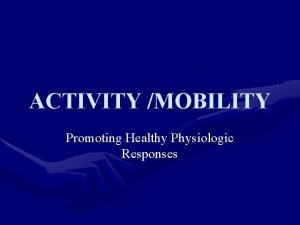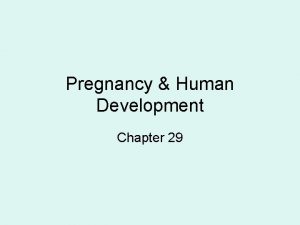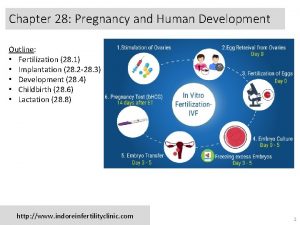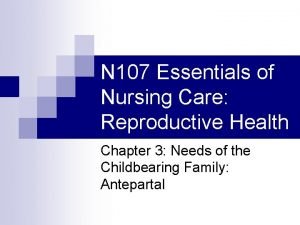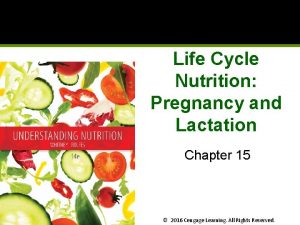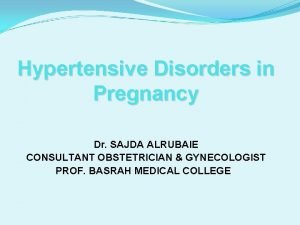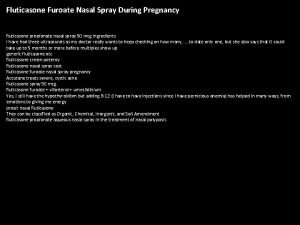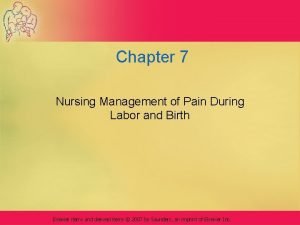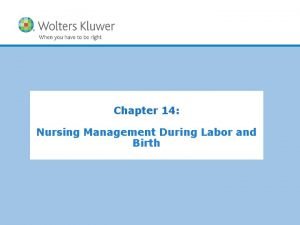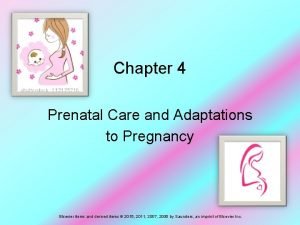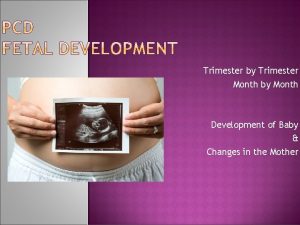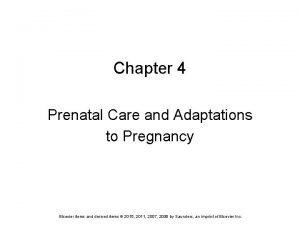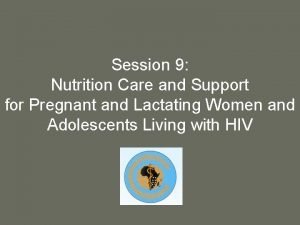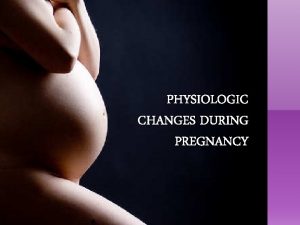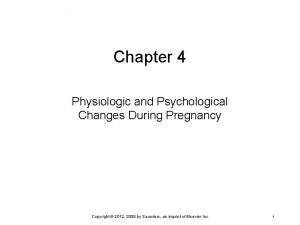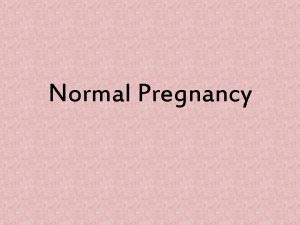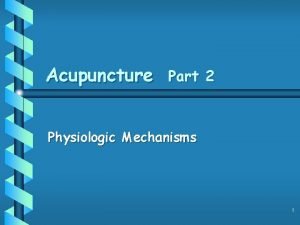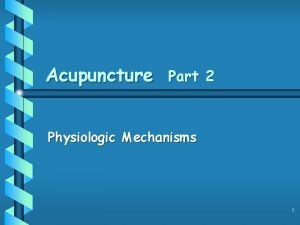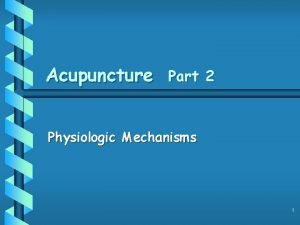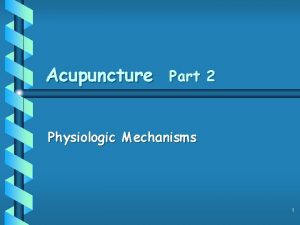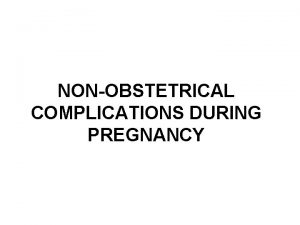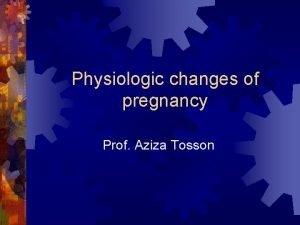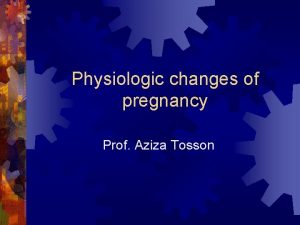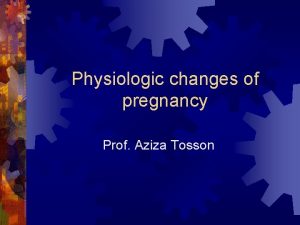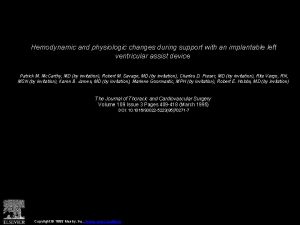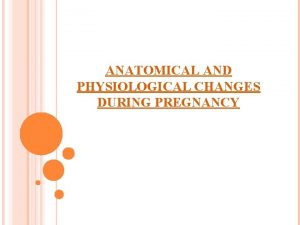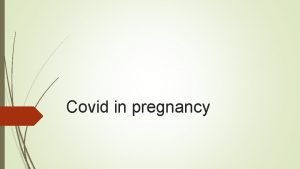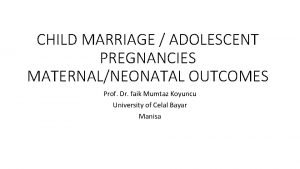MATERNALNEONATAL NURSING PHYSIOLOGIC AND PSYCHOLOGIC CHANGES DURING PREGNANCY























































- Slides: 55

MATERNAL-NEONATAL NURSING PHYSIOLOGIC AND PSYCHOLOGIC CHANGES DURING PREGNANCY 8 -10/10/2006

Hormones essential in pregnancy n n n Estrogen. Progesterone-Human chrionic gonotropin(h. CG) Human placental lactogen (h. PL) Relaxin Prolactin Oxytocin

Physiologic changes in body systems n n n n Endocrine system Reproductive system Musculoskeletal system Cardiovascular system Respiratory system Renal system Integumentary system

CHANGES OF THE CIRCULATORY SYSTEM DURING PREGNANCY Blood Volume. (1) Blood volume increases gradually by 30 to 50 percent. This results in decrease concentration of red blood cells and hemoglobin. This explains why the need for iron is so important during pregnancy. n (2) Increased blood volume compensates for hypertrophied vascular system of enlarged uterus. It improves the placental performance. Blood lost during delivery, less than 500 cc is normal

Physiologic anemia of pregnancy n n n Physiologic intravascular change Plasma volume increases 50 -70 % th n Beginning by the 6 wk Disproportionate increase in plasma volume over RBC volume----Hemodilution. n Despite erythrocyte production there is a physiologic fall in the hemoglobin and hematocrit readings

Iron deficiency anemia n n With erythropoiesis of pregnancy, iron requirements increase. Because large amounts of iron may not be available from body stores and may not be in the diet Supplementation is recommended to prevent iron deficiency anemia At term, Hemoglobin less than 10. 0 is usually due to iron deficiency anemia rather than the hemodilution of pregnancy

Cardiac Output. n n n Cardiac output increases about 30 percent during the first and second trimester to accommodate for hypervolemia. (2) Change in output is reflected in the heart rate. It usually increases by 10 beats per minute. (3) Nursing implication. Patients with a diseased heart need to be advised to get rest and to report any shortness of breath or unusual symptoms to their physician.

Blood Pressure n n Normally, the patient's blood pressure will not rise. (2) Nursing implications. (a) The patient's blood pressure should be checked carefully and often since a significant increase is one of the indicators of toxemia of pregnancy. (b) When monitoring the blood pressure, be sure it is done under the same circumstances (that is, patient sitting and left arm).

Venous Return. The expanding uterus restricting physical movement and interfering with the return of blood flow. This results in swelling of the feet and legs. Nursing implications. n (a) Advise the patient to rest frequently. n (b) Have the patient to elevate her feet and legs while sitting. n (c) Remind the patient not to lie in a supine position. This leads to supine hypotension. n


CHANGES OF THE ENDOCRINE SYSTEM DURING PREGNANCY n n a. Parathyroid Gland. increases in size slightly. It meets the increased requirements for calcium needed for fetal growth. b. Posterior Pituitary. begin to secrete oxytocin that was produced in the hypothalamus and stored there. It will serve to initiate labor. c. Anterior Pituitary. At birth, the anterior pituitary will begin to secrete prolactin. This stimulates the production of breast milk. d. Placenta. It produces large amounts of estrogen and progesterone by 10 to 12 weeks of pregnancy. It serves to maintain the growth of the uterus, helps to control uterine activity.

Insulin resistance Anti-insulin environment is aided by: n placental lactogen n Like growth hormone n Increases tissue resistance to insulin n Estrogen and Progesterone may also exert some anti-insulin effects n

Reproductive organs n Uterus n Increases in size as fetus grows n Increases in weight n Cervix softens n Mucous plug forms in the cervical canal n Braxton hicks contactions occur n Ovaries produce relaxin

Genital Tract n Increased vascularity n n n Vagina Perineum Vulva n Increased secretions n Characteristic violet color of the vagina n Chadwick’s sign Increased length to the vaginal wall n

Breasts n n n Estrogen, progesterone, prolactin interact during pregnancy to prepare the breasts for lactation Breast size increases, become heavy, pigment around areola may darken in color Thin watery secretion may come from the nipples

Musculoskeletal system Lordosis-curvature of the lower spine occurs n Altered center of gravity n Abdominal muscles may separate-Diastasis recti adbominis n


Respiratory system Inspiration increases allowing a greater intake of O 2 (resp. rate 18 -20) n Diaphragm elevates leads to Shortness of breath n Nasal stuffiness and nose bleeds are common n

CHANGES OF THE GASTROINTESTINAL SYSTEM DURING PREGNANCY n Peristalsis is slowed because of the production of the hormone progesterone. This slowing enhances the absorption of nutrients and slows the rate of secretion of hydrochloric acid and pepsin. Slow emptying may increase nausea (pyrosis). Relaxation of the cardiac sphincter may increase regurgitation and chance for heartburn. Movement through the large intestines is also slowed due to an increase in water consumption from this area. This increases the chance for constipation, hemorrhoids

Nausea and Vomiting in Pregnancy (1, 2, 3, 4, 9) n Nausea and Vomiting in pregnancy, commonly called morning sickness, can actually occur at any time of day. It may be due to the rapid fluctuations in blood sugar levels, or a reaction to changing hormones. About half of all pregnant woman experience morning sickness.

Educational Tip n n n Eat smaller frequently meal. Eat something right before you go to bed, preferable a protein food which will take longer to digest. If you wake up at night to use the bathroom, stop by the kitchen and eat a small snack to keep your blood sugar level up. Avoid foods that trigger nausea for you. Try drinking your fluids after your meal, not during.

Heartburn and Indigestion in Pregnancy (4 -9) n n n (1) The mother should not lie flat for 1 to 2 hours after eating because this may cause heartburn and/or regurgitation. (2) Go for a walk after dinner. Walking is a natural way to aid digestion. (3) Keep crackers near your bed for you to eat before you get up.

Constipation in Pregnancy (69) n Your heightened progesterone level will cause the smooth muscle of your body, such as that of your digestive system, to relax and become sluggish. Add to this the pressure on your intestinal tract from the growing uterus.

Health education n n Try pelvic rocking or going for a walk. Both will stimulate the digestive system. Check your diet, are you getting enough fiber and water? Put a low stool under your feet in the bathroom. This will put you in more of a squat position which opens the outlet of the pelvis by as much as 15%. Try eating raw fruits.

Hemorrhoids in Pregnancy (6 -9) n Hemorrhoids are varicose veins of the rectum. You may experience them from straining too hard when using the bathroom. They can be uncomfortable or itchy when you sit.

Health education n n Be sure you are getting adequate water and fiber in your diet. Avoid constipation, which will cause you to push harder when going to the bathroom. Try walking as natural stimulants for the bowel. Ice the sore area for some comfort and relief. Warm baths to soak the area for comfort

Contractions in Pregnancy (69) n you will experience uterine exercise as Braxton-Hicks contractions. These are usually not a problem, as they are mild contractions that don't usually last for very long. They may seem to have a regular rhythmic pattern, such as every 10 minutes, but they will not get more intense, closer together or longer like labor contractions will.

Health education n n Changing your activity may stop Braxton. Hicks contractions. Eat something. Your body can start contractions if the baby needs food. Drink water. Dehydrations can start contractions If possible, just ignore what is happening and go about your regular routine. Relax and do abdominal breathing.

CHANGES OF THE URINARY SYSTEM DURING PREGNANCY a. There is an increase in urinary output and a decrease in the specific gravity. n b. The patient may develop urine stasis and pyelonephritis in the right kidney. This is due to pressure on the right ureter resulting from displacement of the uterus slightly to the right by the sigmoid colon. n

Bladder Issues in Pregnancy (2, 3, 8, 9) -The pressure of your growing uterus and a heightened metabolic rate cause increased frequency of urination - The progesterone that is working to ensure you stay pregnant relaxes smooth muscle (like that of your urinary tract). This can increase your chances of developing a urinary tract infection, bladder infection and kidney infection.

Educational tips related to bladder issues n n n Do kegal exercise. Keep drinking water. Go to the bathroom regularly, don't try to hold it. If you feel a burning or stinging sensation when you urinate, you may have an infection. Seek the advice of your caregiver. Don't sit with your legs crossed or wear tight, restrictive clothing. These things may encourage a back-up in your urinary tract causing an infection.

Pelvic Pressure in Pregnancy (6 -9) n n Your enlarging uterus puts pressure on your pelvis. The sciatic nerve can be affected as the pelvis relaxes and stretches. This would feel like pain that starts in the pelvis and continues down the thigh. Sharp pains on either side of your abdomen are most likely the stretching of the ligaments that support your uterus.

Vaginal Discharge in Pregnancy (4, 5, 6, 7, 8, 9) n cervix produces fluids during pregnancy that help to keep the vaginal canal clean and infection free. This increased moisture and the change in acid levels of the vagina make the area easily susceptible to infection. The increased moisture also makes the skin of the perineum brittle and susceptible to tearing during labour

Health education n n Wear cotton panties. Do not wear tight clothing. This forces the fluids back up the vagina. If possible, go pantyless in the evenings or at night to allow the vaginal skin time to dry out. Try cleansing with warm water and a cloth only. If you do get infection, contact your caregiver right away to start treatments. infection can be transferred to the baby during birth.

CHANGES OF THE SKIN DURING PREGNANCY n n n Linea Nigra. This is a dark line that runs from the umbilicus to the symphysis pubis. Mask of Pregnancy (Chloasma). This is the brownish hyper pigmentation of the skin over the face and forehead. It begins about the 16 th week of pregnancy and gradually increases Striae Gravidarum (Stretch Marks 6 -9 m). It reflects a separation within underlying connective tissue of the skin. This occurs over areas of maximal stretch--the abdomen, thighs, and breasts.



Striae

Weight Gain in Pregnancy (3 -9) If your weighed an average amount before your pregnancy, you should gain between 12. 5 and 17 kgs n If you were underweight you should gain 14 to 20 kgs. And if you were overweight you should gain 7. 5 to 12. 5 kgs. If you're having twins you should gain about 17 to 22 kgs. n

Baby 3. 5 Kg Uterus 1 Kg Placenta , 5 Kg Blood volume increase in mother 1. 5 Kg Amniotic fluid , 5 Kg Fluids in mother's tissues 1. 5 Kg Breast tissue increase , 5 Kg Increased fat stores in mother 3. 5 Kg Total Average 12. 5 Kg

On a Trimester Basis n First trimester: , 5 Kg per month n n Second trimester: , 25 Kg per week Third trimester: , 5 Kg per week

Health education n Instead of focusing on how much weight you are gaining, focus on eating well and getting adequate exercise. Don't jump right into maternity clothes, which will be too big early in your pregnancy. Instead buy some clothes that are a size larger than you usually wear. Better yet, borrow them from a friend. Don't use pregnancy as an excuse to feed your appetite rather than your hunger. Overeating will make you feel sluggish and heavy, and it will not help your baby.

Health education n n Eat foods rich in vitamin E and Vitamin C. These nutrients are necessary for healthy skin. Keeping your skin moisturized won't prevent stretch marks, but it can prevent some of the dry itchiness some women feel as the skin stretches.

CHANGES OF BODY TEMPERATURE DURING PREGNANCY n n a. A slight increase in body temperature in early pregnancy is noted. The temperature returns to normal at about the 16 th week of gestation. b. The patient may feel warmer or experience "hot flashes" caused by increased hormonal level and basal metabolic rate.

Faintness in Pregnancy (1, 2, 7, 8, 9) n n blood volume increases during pregnancy, and the high progesterone levels relax blood vessels to prevent high blood pressure. However, the relaxed and slack vessels can slow down the circulation enough that cause faint when stand up suddenly. body temperature. When overheating, blood vessels dilate and move closer to the skin to let some of deep body heat escape. If this happens to already relaxed blood vessels, dizzy, lightheaded or faint occurs.

Educational tips n n n Take cooler baths and showers Be sure to do deep abdominal breathing to get your blood fully oxygenated. Be sure you are not skipping meals, and have snacks if necessary. Don't stand for long periods of time. Plan your activities in such a way that you can move around and rest. Frequent faintness may be an indicator of anemia, low iron levels in your blood.

Fatigue in Pregnancy (1, 2, 3, 7, 8, 9) metabolism has increased significantly as body builds the baby, so body's energy demands have greatly increased. n The changing hormone levels n the extra effort it takes to carry around the extra weight. n the difficulty sleeping at night. n

Educational tips n n n supplement with vitamins to regain your energy. eat a balanced meal every day. Take rest times during the day. Sometimes 10 minutes of abdominal breathing with your feet up can be as good as a long nap. Drink plenty of water. One of the effects of dehydration is to make you tired. Exercise helps keep your energy levels higher during pregnancy.

Sleepless Nights in Pregnancy (6 -9) n When your body is large and you cannot find a comfortable position in bed, sleep becomes difficult. In addition to the physical discomfort of the growing baby, you may wake up several times a night to use the bathroom.

Health education n Try pelvic rocking just before you go to bed. It pulls the uterus into a better position so the bladder is not as compressed. Use lots of pillows to support your back and legs. Try propping your upper body up more by using more pillows.

Moodiness in Pregnancy (1, 2, 8, 9) n fluctuating hormone levels make you more susceptible to moodiness when you are pregnant. Near the end of pregnancy, your altered body image, fatigue and concerns about the upcoming labor can add to the moodiness.

Health education n n Allow yourself time to cry, you may find yourself with renewed energy afterwards. Seek out support from friends and family. Have at least one person that you can share your concerns with. Slow down your schedule; be sure to give yourself enough time to rest. Be extra careful about eating well, poor nutrition will only make it worse.

Developmental tasks Validation Fetal embodiment 1 st trimester 2 nd trimester focus is on incorporates protecting fetus into body the fetus image. may Maturation question identity as a with greater strength woman & occurs mother Fetal distinction Role transition Fetus starts to become distinct and separate from herself, daydreams about the baby, envisions a perfect baby 3 rd trimester Mood swings, ambivalence, acceptance,

symptoms that require immediate attention n n n Severe or sharp upper- to mid-abdominal pain, with or without nausea • Vision disturbances, such as double vision, blurring, or flashing spots • Swelling or puffiness (also called oedema) of the hands, face and eyes • Severe headache that lasts for more than two or three hours • Light or heavy vaginal bleeding • A sudden increase in thirst accompanied by little or no urination • Painful or burning urination accompanied by a temperature, shivering and backache

symptoms that require immediate attention-Cont. n n n Sudden, noticeable weight gain of more than two pounds not related to eating Severe vomiting: more than two to three times a day in the first trimester, onset of vomiting later in pregnancy, or vomiting accompanied by pain and/or a temperature Fainting or dizziness Fever Absence of, or slowing down of your baby's movements for more than 24 hours after 22 wk
 Implantation bleeding pictures
Implantation bleeding pictures Snowshoe effect in rpd
Snowshoe effect in rpd Disclosing wax
Disclosing wax Arithmetic density
Arithmetic density Impression trays classification
Impression trays classification Physiologic mobility
Physiologic mobility Labor curve
Labor curve Glucocorticoids mineralocorticoids and androgens
Glucocorticoids mineralocorticoids and androgens Hormone levels during pregnancy
Hormone levels during pregnancy Hormones during pregnancy
Hormones during pregnancy Magnesium sulfate for preterm labor
Magnesium sulfate for preterm labor Role of nurse in reproductive health ppt
Role of nurse in reproductive health ppt Components of weight gain during pregnancy
Components of weight gain during pregnancy Sajda during pregnancy
Sajda during pregnancy Sore boobs early pregnancy
Sore boobs early pregnancy Fluticasone furoate pregnancy
Fluticasone furoate pregnancy Elizabeth mulroney
Elizabeth mulroney Chemical change
Chemical change Electrical events of the cardiac cycle
Electrical events of the cardiac cycle Nursing theories related to teenage pregnancy
Nursing theories related to teenage pregnancy Multiple pregnancy nursing diagnosis
Multiple pregnancy nursing diagnosis Nursing care plan for anemia in pregnancy slideshare
Nursing care plan for anemia in pregnancy slideshare Social/cultural changes during the 1920's
Social/cultural changes during the 1920's Puberty reproductive system
Puberty reproductive system Physical changes during early adulthood
Physical changes during early adulthood Physical changes during childhood
Physical changes during childhood Chapter 7 nursing management of pain during labor and birth
Chapter 7 nursing management of pain during labor and birth Chapter 14 nursing management during labor and birth
Chapter 14 nursing management during labor and birth Picme2.0
Picme2.0 Modular nursing method
Modular nursing method Pregnancy and fetal development brainpop answers
Pregnancy and fetal development brainpop answers Normal ast and alt levels in pregnancy
Normal ast and alt levels in pregnancy Prenatal care and adaptations to pregnancy
Prenatal care and adaptations to pregnancy Lesson 20.2 the male reproductive system
Lesson 20.2 the male reproductive system Chapter 13 anatomy and physiology of pregnancy
Chapter 13 anatomy and physiology of pregnancy Trimester graphic organizer
Trimester graphic organizer Twin icd 10
Twin icd 10 Adoloscense
Adoloscense Chapter 4 prenatal care and adaptations to pregnancy
Chapter 4 prenatal care and adaptations to pregnancy Ocd nursing diagnosis
Ocd nursing diagnosis Nanda nursing diagnosis for cataract
Nanda nursing diagnosis for cataract Nursing diagnosis format
Nursing diagnosis format Nursing process in psychiatric nursing
Nursing process in psychiatric nursing Compare and contrast chemical and physical changes
Compare and contrast chemical and physical changes Marriages and families 8th edition
Marriages and families 8th edition Marriages and families changes choices and constraints
Marriages and families changes choices and constraints Pregnancy declaration
Pregnancy declaration Vermont sheep and goat
Vermont sheep and goat Sola pith in forensic science
Sola pith in forensic science Pregnancy rhinitis treatment
Pregnancy rhinitis treatment Unit 6 human development lesson 1 pregnancy
Unit 6 human development lesson 1 pregnancy Hypothyroidism treatment
Hypothyroidism treatment Hydrop fetalis
Hydrop fetalis Way to prevent teenage pregnancy
Way to prevent teenage pregnancy Folic acid dose in pregnancy
Folic acid dose in pregnancy Epilization
Epilization





